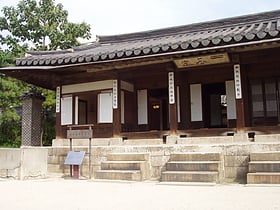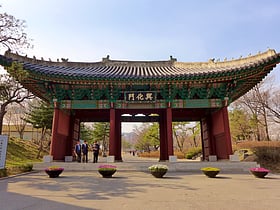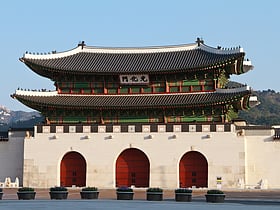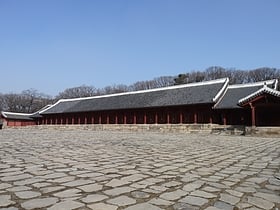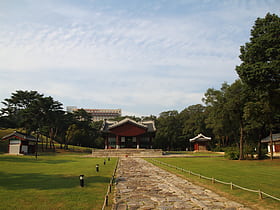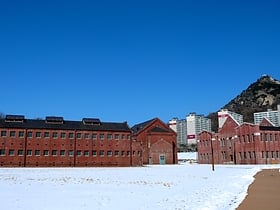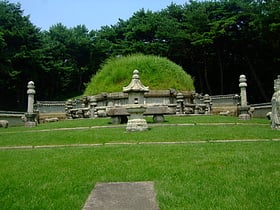Seoul: Historical Place
Places and attractions in the Historical place category
Categories
- Museum
- Neighbourhood
- Art museum
- Park
- Bridge
- History museum
- Universities and schools
- Specialty museum
- Shopping
- Historical place
- Buddhist architecture
- Temple
- Church
- Vernacular architecture
- Market
- Skyscraper
- Mountain
- Theater
- Sport
- Sport venue
- Natural attraction
- Nature
- Library
- Art gallery
- Sacred and religious sites
- Concerts and shows
- City gate
- Unesco
- Fashion museum
- Palace
- Monuments and statues
- Arenas and stadiums
- Archaeological site
- City
- Concert hall
- Nightlife
Unhyeongung
Royal and political palace residence Unhyeongung, a lesser-known yet historically significant palace nestled in the bustling heart of Seoul, South Korea, offers visitors a glimpse into the country’s regal past. This cultural gem once served as the residence of Heungseon Daewongun, the father of King...
Gyeonghuigung
Historic palace with an adjacent museum Gyeonghuigung, a serene historical gem nestled in the bustling city of Seoul, South Korea, stands as a testament to the Joseon Dynasty's architectural splendor. This palace, which served as a secondary royal villa for the king, is an emblem of Korea's rich cultural...
Gwanghwamun
Imposing gate at Gyeongbokgung Palace Gwanghwamun is the main and largest gate of Gyeongbokgung Palace, located in Seoul, South Korea. Serving as a landmark historical site, this majestic gate stands as a proud emblem of the city's rich heritage and dynastic past.
Jongmyo
Shrine to Joseon dynasty kings and queens Jongmyo Shrine is a serene and historical sanctuary nestled in the heart of Seoul, South Korea. Established in the 14th century during the Joseon Dynasty, Jongmyo is the oldest and most authentic of the Confucian royal shrines to have been preserved.
Seonjeongneung
In the heart of Seoul's modern cityscape lies Seonjeongneung, a UNESCO World Heritage site that offers a tranquil escape from the urban rush. This royal tomb complex, dating back to the Joseon Dynasty, is the resting place of two kings and one queen, encapsulating...
Seodaemun Prison
Prison history museum in 1908 jail Seodaemun Prison stands as a stark reminder of Korea's tumultuous history and its struggle for independence. Located in the bustling city of Seoul, this former prison now serves as a museum, shedding light on the dark days of Japanese colonial rule.
Samjeondo Monument
The Samjeondo Monument stands as a historical testament to a pivotal moment in Korean history, located in the bustling city of Seoul, South Korea. This memorial marks the site where, in 1636, the king of the Joseon Dynasty was forced to sign the humiliating Treaty of...
Independence Gate
Dongnimmun Gate is a memorial gate located in Seoul, South Korea. The gate was built following the First Sino-Japanese War to inspire a spirit of independence away from Korea's previous status as a Chinese tributary state, which was declared by the Treaty of Shimonoseki. It was designed by Soh Jaipil, a Korean political activist.
Heunginjimun
Historic gate of the Fortress Wall Heunginjimun, literally "Gate of Rising Benevolence" or more commonly known as Dongdaemun, is one of The Eight Gates of Seoul in the Fortress Wall of Seoul, a prominent landmark in central Seoul, South Korea.
Dongmyo
Dongmyo is a shrine in metropolitan Seoul built in honour of the 3rd century Chinese military commander, Guan Yu. The Joseon government embarked on construction in 1599 and completed the work in 1601. The Wanli Emperor of Ming provided funds for construction of the shrine, along with a plaque with his own calligraphy.
Changuimun
Changuimun is one of the Eight Gates of Seoul in the Fortress Wall of Seoul, South Korea, which surrounded the city in the Joseon Dynasty. The gate is also known as Buksomun, and Jahamun.
Donggureung
Donggureung, meaning "East Nine Royal Tombs", is a cluster of Joseon Dynasty royal tombs, the largest of its kind in South Korea. 17 Joseon kings and queens are buried here. The cluster houses a myo type tomb, as well. The cluster is located in Guri, Gyeonggi-do.
Hyehwamun
Hyehwamun is one of the Eight Gates of Seoul in the Fortress Wall of Seoul, South Korea, which surrounded the city in the Joseon Dynasty. The gate is also known as Dongsomun.
Gwanghuimun
Gwanghuimun is one of The Eight Gates of Seoul in the Fortress Wall of Seoul, South Korea, which surrounded the city in the Joseon Dynasty. The gate is also known as Namsomun.
Bosingak
Joseon-era belfry used for timekeeping Bosingak is a large bell pavilion on Jongno in Seoul, South Korea. The bell in Bosingak gives Jongno its name, which literally means "bell street". It was originally constructed in 1396 but destroyed many times by both war and fire. It was designated Bosingak by Emperor Gojong in 1895.
Sukjeongmun
Sukjeongmun is one of the Eight Gates of Seoul in the Fortress Wall of Seoul, South Korea, which surrounded the city in the Joseon Dynasty. The gate is also known as Bukdaemun. It was built north of Seoul behind Gyeongbokgung Place. It was rarely used. It was only used in ceremonious and symbolic functions.
Map

